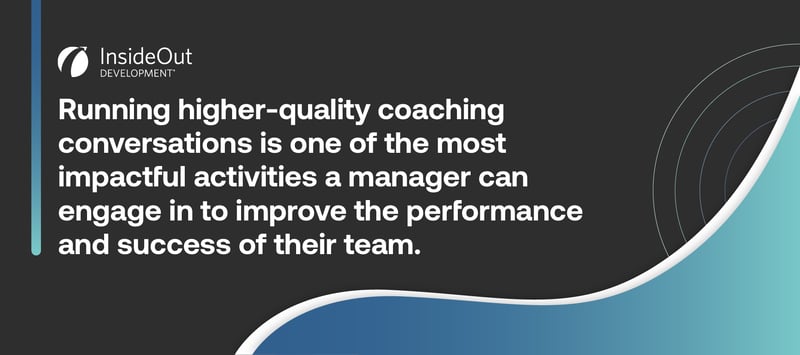Is there a conversation you’ve been putting off? Whether it’s talking to a direct report who is performing poorly or confronting your teen about a messy room, maybe you’ve tried before and it went badly. Or maybe you fear that talking will only make the situation worse.
We’ve all been a part of difficult conversations that went terribly wrong. There were meltdowns, hard feelings — maybe even ruined relationships. That’s why it can be hard to want to bring up a difficult subject.
The following tips will make your mountainous “tough” conversations more surmountable.
But First, How Not to Communicate
If you want your team to see conversations for the waste of time you know they are, these tips are for you. Check out this blueprint for a poor conversation that will keep your team from bothering you ever again:
- Just Wing It: Conversations are supposed to be casual. Walking into a tough conversation with an agenda could set off some serious red flags for the person on the receiving end.
- Don’t Plan Ahead: Planning is important for marketing plans, budget audits, and strategy meetings — not for everyday conversations.
- Jump Right In: Practice makes boring. There’s no better feedback than what you receive from the reactions that someone has to what you say in the moment.
- Up the Ante: People work best under a hard deadline. There isn’t a better motivator than tying results and job security with the same knot.
- Make It Meaningless: Conversations are best spent asking questions about the weekend and how excited we are about the new Taylor Swift album.
Hopefully, you’ve realized that was all really bad advice. You wouldn’t actually do any of that, right?

Successful leaders understand that meaningful conversations improve productivity, increase employee satisfaction, and drive profits. The best leaders follow a better blueprint.
3 Things to Do Before Your Tough Conversation
Having tough conversations with employees is like building muscle — the more you exercise, the stronger you get. Preparing, planning, and practicing are the exercises required to scale the mountain preventing productive dialogue.

1. Prepare
Any tough conversation starts with a conversation with yourself. This conversation — not the one with the other person — is the toughest one you’ll have. Here are some tips for preparing for tough conversations:
- Articulate the Issue: Tough conversations shouldn’t be held out of frustration, but rather to accomplish a goal that relieves the frustration. What’s the real problem you’re trying to solve? If you can’t succinctly articulate the issue before starting the conversation, you certainly won’t be able to communicate your concerns during it.
- Determine Expected Outcomes: Effective conversations start with a clear end goal. Define what success looks like for the conversation. Ensure the other person understands and aligns with your goal before proceeding. While you may refine the goal in the moment, having a starting point is essential.
- Examine Your Emotions: To navigate tough conversations effectively, acknowledge and manage your emotions to avoid hindrance. Remember, you're not responsible for the other person's feelings. While you can't control their emotions, you can control your response to them.
2. Plan
Plan in detail what you intend to say and do. Determine what questions you want to ask, and anticipate how the other person will respond.
Begin tough conversations by using “I” statements (“I have a problem”) rather than “you” statements (“you have been…”). “You” statements tend to make people defensive and less open to hearing what you have to say and truly collaborating to solve the problem.
It’s also important to plan an appropriate time and place for the conversation. Consider what distractions could hamper a productive conversation and plan accordingly. Generally, these conversations should take place in a private, one-on-one setting at a time when you can both give your full attention.
3. Practice
You might begin by practicing the conversation silently or aloud by yourself, but don’t neglect to practice with someone else. Recruit a trusted co-worker, friend, or family member to help you practice your responses to unanticipated reactions in real time.
Practicing with someone else also helps develop active listening skills. Ensure you comprehend the other person's message by focusing on understanding rather than immediate response. Paraphrase their words to maintain focus on their message. Then, take a moment after listening to formulate your response.
Don’t worry if the first practice session doesn’t go well. Allow yourself as many “do-overs” as needed so you feel confident and comfortable. If you aren’t comfortable, you can’t help the other person be comfortable, which will stifle the flow of solutions for both of you.
5 Tips for Handling Tough Conversations
Over two-thirds of managers cited in one study said they’re often uncomfortable having tough conversations at work. It’s one of the most prevalent manager problems.
Sometimes, these conversations feel like a mountain standing between you and drawing great performance out of your team. So, how do you handle them? Here are five basics to help you do just that:
1. Be Respectful
Numerous philosophies exist on effective communication, spanning cultures, genders, and societal divides. Yet, they all converge on one key ingredient: genuine respect.
Whether in brief check-ins or feedback sessions, conveying trust, recognition, and value fosters healthy relationships. By posing three simple questions — What’s working? Where are you getting stuck? What might you do differently? — and allowing others to self-assess first, signals confidence and respect.
After they have shared (and you demonstrate that you have, indeed, heard them) then you can answer those same questions for yourself, adding anything that’s still relevant.
As familiar and simple as these questions are, when used in this way and with a mindset of genuine respect, the results can be profound. If we can be more intentional and demonstrate respect in these brief but important dialogues that occur multiple times a day, we’ll create communication that knows no boundaries.
2. Create an Engaged Environment
Gallup reports that environments with low employee engagement experience 18% lower productivity, 16% lower profitability, and 65% lower share of price.
To foster employee engagement, create a safe environment for giving and receiving feedback. How? Begin by establishing trust, regularly initiating two-way conversations, and listening more than you talk.
3. Manage Your Own Emotions
No matter how well the conversation begins, you’ll need to stay in charge of yourself, your purpose, and your emotional energy. Here are some questions you can ask yourself:
- Why do I want/need to have this conversation? What is my goal?
- What attitude do I have toward the other person?
- What incorrect assumptions might I have made about the situation?
- What previous experiences with this person/situation are influencing me?
- Why have I delayed dealing with this issue/person?
4. Make It Meaningful
Conversations can be a little scary. Hearing, “We need to talk,” “When you get a second, step into my office,” and similar phrases can overwhelm us with possibilities.
The greatest conversations leave you in awe, inspired, and excited for change even if they didn’t start out as a positive dialogue. Don’t waste time, get to the meat of the problem and collaborate to find the ideal solution. Collaboration requires a shift away from monologue to dialogue.
5. Follow Up, Reflect, and Improve
After you’ve listened to each other, make a plan for moving forward. Agree on a due date for action, along with a process to review progress. Following up may include periodically checking in, providing feedback, and maybe even occasional nudging, if necessary.
Summarize what you’ve agreed upon, and, finally, thank the employee for agreeing to discuss the situation with you.
Regardless of how the conversation actually finishes, reflect on what went well and what you could do better next time. What did you learn? What could you have done differently? How can you prevent a similar situation from occurring again?
By considering these points before facilitating tough conversations, you can reduce your own interference and help generate positive and productive outcomes for you and your team.
Use Coaching to Master Tough Conversations Worth Having
A positive, effective, and impactful manager considers themselves (or at least desires to be) a coach to their team — someone who runs conversations that instill confidence, increase engagement and motivate those they work with.
The research is compelling: Running higher-quality coaching conversations is one of the most impactful activities a manager can engage in to improve the performance and success of their team.
Whether you consider yourself a coach or not, you can create better working relationships, ease communication problems, and improve the quality of your work environment by caring enough to hold difficult conversations effectively.
Start your tough conversations training with our free eBook, “Core Coaching Characteristics (and Why You Should Care).”





